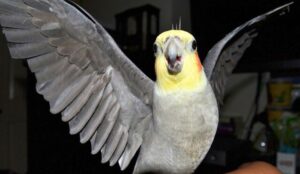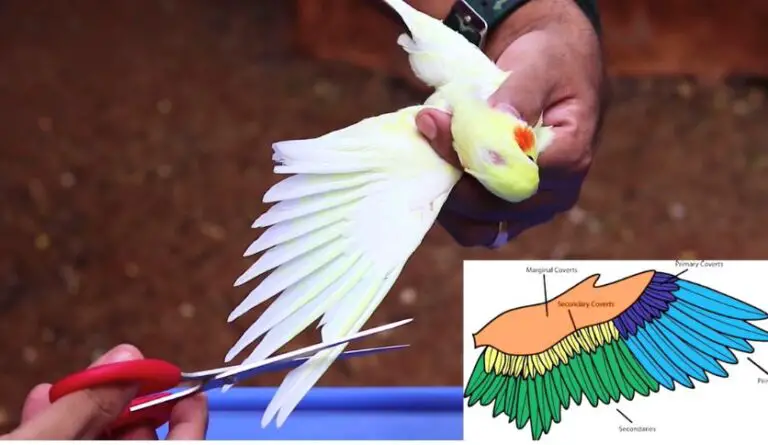To clip a cockatiel’s wings, securely hold the bird, identify the primary flight feathers, and trim them with sharp bird scissors, carefully avoiding cutting the blood feathers. Clipping feathers too short can cause injury, so it’s best to consult a vet or an experienced bird groomer to ensure a safe and proper procedure.
Cockatiels are social and active birds that enjoy flying. However, it may be necessary to clip their wings for safety or to prevent them from escaping. Clipping a cockatiel’s wings involves trimming the primary flight feathers, restricting their flying ability.
It is important to approach this task with caution and knowledge to avoid harming the bird. This article guides how to clip a cockatiel’s wings safely and effectively, emphasizing the need for professional assistance. Properly clipped wings can keep these beloved pets safe while ensuring their continued well-being and happiness in their human environment.
Understanding The Importance Of Wing Clipping
Understanding the significance of wing clipping is vital when considering the well-being of your cockatiel. Discover the step-by-step process of how to clip cockatiel wings to ensure their safety and prevent potential flight-related accidents.
Understanding the Importance of Wing ClippingBenefits of clipping a cockatiel’s wings: – Preventing accidents and injuries: Trimming a cockatiel’s wings can help prevent them from flying into hazards or colliding with objects, reducing the risk of accidents and injuries. – Ensuring a safe living environment: Clipping their wings allows cockatiels to safely explore their surroundings without the risk of getting lost or injured. – Promoting social interaction: By restricting their flight abilities, cockatiels are more likely to bond with their human companions and engage in social activities. – Preventing territorial behavior and aggression: Wing clipping can help reduce territorial behavior and aggression in cockatiels, making them easier to handle and interact with. – Easier training and taming: With clipped wings, cockatiels are more receptive to training and taming, as they are less likely to fly away during the process. – Reducing hormonal behavior: Clipping wings can help reduce hormonal behavior in cockatiels, such as excessive egg laying or aggressive mating tendencies. Clipping a cockatiel’s wings should be done safely and properly
The Right Tools For Wing Clipping
You will need a few essential tools to clip your cockatiel’s wings successfully. One of the most important tools is bird nail clippers. Different types of clippers are available, such as scissor-shaped clippers and guillotine-style clippers. Choosing the right size of clippers for your cockatiel is important, ensuring that they are comfortable to hold and easy to handle. Trimming your bird’s wing feathers requires precision and care, so investing in high-quality clippers is crucial. Additionally, you may want to have a styptic powder or cornstarch on hand to stop bleeding in case of accidental cuts. Remember, wing clipping should be done with caution and preferably by a professional to avoid causing any harm or stress to your feathered friend.
Step-by-step Guide To Clipping Cockatiel Wings

Clipping cockatiel wings is essential to ensuring your pet bird’s safety and well-being. To help you through the process, here are some tips and techniques to consider:
Preparing Your Cockatiel For Wing Clipping
Before clipping your cockatiel’s wings, creating a calm environment is important. Prepare a comfortable space with necessary supplies such as sharp bird scissors and styptic powder. Additionally, ensure you have treats to reward positive behavior and a towel or soft cloth to restrain your bird gently.
Proper Handling Techniques During The Process
Handle your cockatiel with care throughout the wing clipping process. Use a gentle yet firm grip to prevent any sudden movements. Hold the bird’s wings firmly but not too tightly to avoid causing any discomfort. Keep a close eye on the feather coloration to identify the blood feathers that should be avoided during trimming.
Avoiding Common Mistakes And Risks
One common mistake is trimming the wings too short. Always aim to maintain some flight control, allowing your cockatiel to glide and land safely. It is also important to avoid cutting the blood feathers as they can cause excessive bleeding and pain. If unsure, consult an avian veterinarian or an experienced bird groomer.
Tips For Making The Process Less Stressful For Your Bird
To minimize stress during wing clipping, follow these tips: create a quiet and distraction-free environment, reward your cockatiel with treats and praise for good behavior, keep the wing trimming session short, and consider seeking professional help if you are unsure or uncomfortable with performing this task.
Locating The Primary Flight Feathers
Identifying the primary feathers on a cockatiel’s wings is vital when clipping them. Cockatiels have two sets of feathers on their wings – primary and secondary. Primary feathers are the outermost and longest feathers, responsible for providing lift during flight. These feathers are attached to the cockatiel’s hand, forming the primary feather group.
You must locate the longest and outermost feathers on the wing to identify the primary feathers. These feathers are typically bristly and stand out from the rest of the plumage. They can be seen when the cockatiel extends its wings fully. Counting from the edge of the wing towards the body, you’ll find the primary feathers.
Understanding the anatomy of the wing is crucial to avoid clipping the wrong feathers. By identifying the primary feathers accurately, you can safely trim them to prevent full flight while ensuring the cockatiel’s comfort and safety.
Trimming Technique For Cockatiel Wings
Learn the effective trimming technique for cockatiel wings to keep your pet bird safe and prevent them from flying away. This step-by-step guide will help you clip their wings safely and stress-freely.
When clipping cockatiel wings, it’s important to trim the primary feathers to the correct length to ensure your bird’s safety and mobility. However, it’s crucial to avoid clipping the blood feathers, which can cause bleeding and pain to your feathered friend. Here’s a step-by-step guide to help you safely and effectively trim your cockatiel’s wings:
- Gather the necessary materials, including a pair of bird clippers or scissors, a towel, and a styptic powder.
- Find a calm and quiet space to perform the trim. Make sure your cockatiel is comfortable and relaxed.
- Wrap your bird gently in a towel, exposing one wing at a time.
- Identify the primary feathers located at the end of the wing. These are the feathers to be trimmed.
- Using the clippers or scissors, carefully trim about 1/3 to 1/2 inch off the primary feathers.
- Double-check that you haven’t clipped any blood feathers.
- If bleeding occurs, apply styptic powder to stop it.
- Repeat the process for the other wing.
- Offer treats and praise to your cockatiel for a positive experience.
Remember to consult with an avian veterinarian or an experienced bird groomer if you’re unsure or uncomfortable performing the wing trim yourself.
Monitoring The Results And Adjusting As Needed
Once you have clipped your cockatiel’s wings, monitoring the results and being attentive to any necessary adjustments is crucial. Start by observing your bird’s behavior after the wing clipping. Pay close attention to how they navigate their surroundings and interact with their cage and toys. This will help you assess their flight ability and ensure their safety. You may need to modify the trim if you notice any imbalance or difficulty in maintaining proper balance. By slightly adjusting the wing feathers, you can ensure that your cockatiel achieves the desired level of flight control without compromising their safety. Remember to be patient and flexible in your approach, as each bird is unique and may require different trimming techniques.
How Often Should Cockatiel Wings Be Clipped?
Clipping a cockatiel’s wings is an important aspect of their care and can help to keep them safe and prevent accidents. Determining the frequency of wing trimming is crucial in maintaining their flight capabilities and ensuring their safety. Clipping a cockatiel’s wings every 4-6 weeks is generally recommended. However, the frequency may vary depending on factors such as the bird’s age, level of flight skills, and environmental safety measures.
Regular trimming can help to prevent flight-related accidents, such as collisions with windows or ceiling fans. It is vital to balance allowing the bird to experience limited flight and avoiding situations that may endanger its well-being. Observing the bird’s behavior and flight capabilities allows you to determine if it is time for a wing clipping. Consultation with a veterinarian or an avian specialist can provide additional guidance specific to your cockatiel’s needs.
Can Wing Clipping Harm My Cockatiel?
Clipping a cockatiel’s wings is a topic that often raises concerns among bird owners. Many worry about the potential harm and stress it may cause their feathered friends. However, it’s important to address these concerns and provide accurate information. The truth is that when done correctly, wing clipping can be a safe and effective way to ensure your cockatiel’s safety. A properly trimmed wing will prevent your bird from flying long distances or getting into dangerous situations, such as getting trapped or injured. It’s important to note that wing clipping should be done by a professional or an experienced bird owner who understands the proper technique. This ensures the bird is not harmed and the feathers are trimmed correctly. By following the correct procedure and seeking guidance from a knowledgeable source, you can help keep your cockatiel safe without causing any harm.
What If My Cockatiel Hates Wing Clipping?
Clip your cockatiel’s wings professionally to ensure its safety and prevent flying into harmful obstacles. However, some cockatiels may be resistant or fearful of wing clipping. Be patient and use these tips to help your feathered friend through the process.
- 1. Create a calm environment: Choose a quiet room where your cockatiel feels safe and comfortable. Minimize distractions and sudden movements.
- 2. Gain trust through bonding: Spend quality time with your cockatiel, earning its trust through positive interactions. Offer treats, gentle touches, and soothing words.
- 3. Gradual introduction: Start by introducing the wing clipper to your cockatiel, making it familiar with the tool. Hold it near the bird without making any sudden movements.
- 4. Step-by-step approach: Gradually introduce the concept of wing clipping by holding the wing gently, without actually clipping it. Repeat this process until your cockatiel becomes more comfortable with the handling.
- 5. Seek professional assistance: If your cockatiel remains resistant, seek help from a professional bird groomer or an avian veterinarian with experience handling fearful birds.
Remember, every bird is unique, so be patient and understanding during the wing clipping. Your cockatiel’s safety and well-being should always be the top priority.
Should I Trim One Wing Or Both?
Trimming a cockatiel’s wings can be a controversial topic among bird owners. When deciding whether to trim one wing or both, it’s essential to consider the pros and cons of each option.
Trimming only one wing can help maintain flight stability while preventing the bird from flying off. This method allows the bird to have some freedom for exercise while ensuring it remains safely within its environment. However, one-sided trimming may result in imbalanced flight and potentially cause injury. Additionally, monitoring the trimmed wing regularly is vital to ensure that the feathers are regrowing evenly.
On the other hand, trimming both wings completely restricts the bird’s ability to fly. This can provide a safer environment, especially if potential hazards are nearby. However, it can also hinder the bird’s physical and mental stimulation, diminishing its overall quality of life.
Ultimately, the decision to trim one wing or both depends on various factors, including the bird’s temperament, living conditions, and safety concerns. It’s crucial to consult with an avian veterinarian or bird behavior expert to determine the best approach for your cockatiel’s well-being.
Can I Clip My Cockatiel’s Wings At Home?
Wing clipping is a common practice for pet cockatiels to prevent them from flying away or injuring themselves. Some bird owners consider doing it themselves at home, but it’s important to weigh the risks and benefits before attempting this procedure.
Inexperienced owners may accidentally cut too many flight feathers, resulting in imbalanced wings and difficulties in flying. Mishandling during the process can also cause stress and injury to the bird. On the other hand, there are some advantages to DIY wing clipping. It saves you money on veterinary fees and gives you more control over the process.
If you decide to clip your cockatiel’s wings at home, following proper techniques and guidelines is crucial. Research and consult avian experts to ensure you understand the correct feather-trimming method. Use sharp, clean scissors designed explicitly for bird wing clipping and work in a calm, well-lit environment to minimize stress for your bird.
| Risks | Benefits |
|
|
When Should I Seek Professional Help?
Recognizing when it’s best to consult a veterinarian or avian specialist is crucial when it comes to clipping your cockatiel’s wings. Your pet’s safety and well-being should always be the top priority. There are certain situations where seeking professional help is necessary:
- First-Time Clipping: If you have never clipped your cockatiel’s wings before, seeking professional guidance is strongly recommended. They can show you the proper technique and ensure the procedure is done safely.
- Injury or Bleeding: If you accidentally cut too close to a blood feather and your cockatiel starts bleeding, you must immediately consult a veterinarian or avian specialist. They can address the situation promptly and provide the necessary medical care.
- Abnormal Behavior or Health Issues: If your cockatiel exhibits abnormal behavior or health problems after wing clipping, it is best to consult an expert. They can assess the situation, determine if the wing clipping is related, and recommend appropriate treatment or adjustments.
- Specific Bird Species: Certain bird species may have unique considerations or requirements regarding wing clipping. Consulting a professional specializing in avian care ensures that your cockatiel’s needs are met.
Re-growing Flight Feathers: What To Expect
The regrowth process of cockatiel flight feathers is natural and gradual and requires patience and understanding. After clipping their wings, cockatiels start the process of growing new flight feathers. This process can take several months, and it is important to be patient during this time. During the early stages of regrowth, you may notice small, pin-like feathers emerging from the feather follicles. These are called blood feathers and are delicate and sensitive. It is important to avoid handling or excessive stress during this stage to prevent any harm to these new feathers. As the feathers continue to grow, they will start to unfurl and develop their distinctive shape. It is important to provide a healthy and balanced diet during this time to support feather growth. Once the new flight feathers have fully grown and unfurled, your cockatiel will regain their ability to fly. It is important to monitor their flight behavior and ensure they have enough space to navigate their surroundings safely. By understanding the regrowth process of cockatiel flight feathers, you can provide the necessary care and support during this important phase in your cockatiel’s life.
Frequently Asked Questions For How To Clip Cockatiel Wings
Is It OK to Clip A Cockatiel Wings?
Yes, it is okay to clip a cockatiel’s wings. Clipping helps prevent flying accidents and keeps them safe. However, it should be done carefully and by a professional to avoid causing harm or distress to the bird.
How Long Does It Take For A Cockatiels Wings To Grow Back After Clipping?
Cockatiel wings usually take 6-12 weeks to grow back after clipping. Regular flight exercises can help speed up the process and ensure healthy wing growth.
How Often Should I Clip My Cockatiel’s Wings?
It is recommended to clip your cockatiel’s wings every 3 months to prevent them from flying away or injuring themselves while in flight.
How Do I Clip My Cockatiel’s Wings Without Hurting Them?
To clip your cockatiel’s wings without hurting them, position them securely and use sharp, clean scissors to trim only the primary flight feathers. Avoid cutting too close to the body, and make sure to consult a veterinarian or professional for guidance if you are unsure.
Conclusion
Clipping cockatiel wings is a crucial aspect of bird care that should be approached with caution and knowledge. By following the proper techniques and guidance, you can ensure the safety and well-being of your feathered friend. Remember to consult a veterinarian or an experienced bird owner before attempting to clip your cockatiel’s wings.
You can provide a comfortable and secure environment for your cockatiel to thrive in with care and attention.

Hi, I’m Regina Rios. Just another bird lover who loves to share knowledge from personal experience. I’ve grown up with pet birds since childhood as my mommy also loves birds. As I can’t pet many birds in open air in my house as my mom does; I created my first bird cage on my rooftop using wood, copper wire, and a metal shed in 2018 and start collecting pet birds. Now, I have so many pet birds such as Macaws, Parrot, Cockatiel, Parakeet, and others. Not only that, if I see natural birds are injured I keep them in my house until they get well. Now, my hobby becomes my income source as my home birds have babies and I sell them to birds lover like mine. I’ve created this blog to inspire others bird owners by sharing my personal knowledge. Good Luck!

